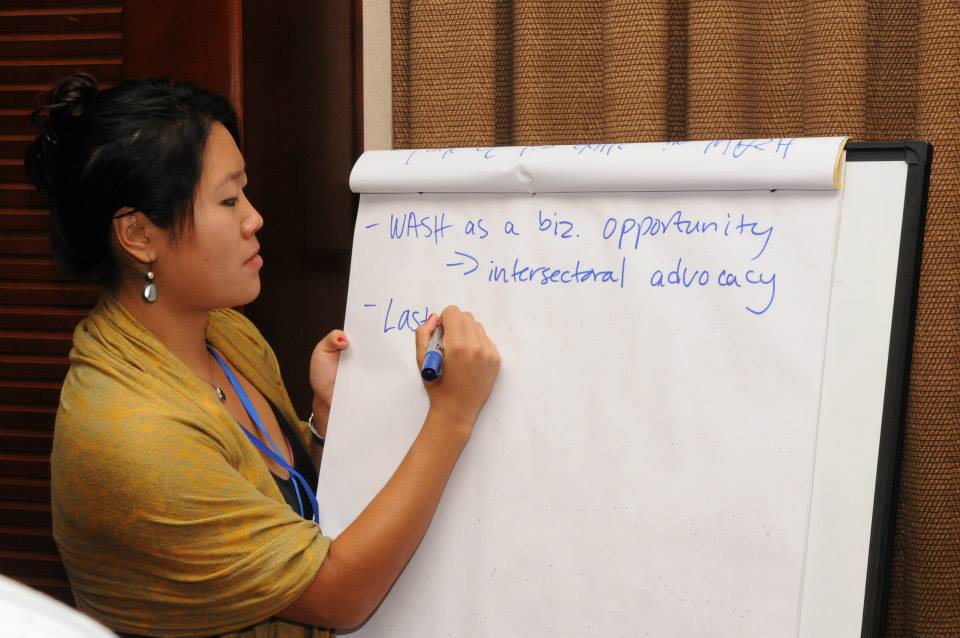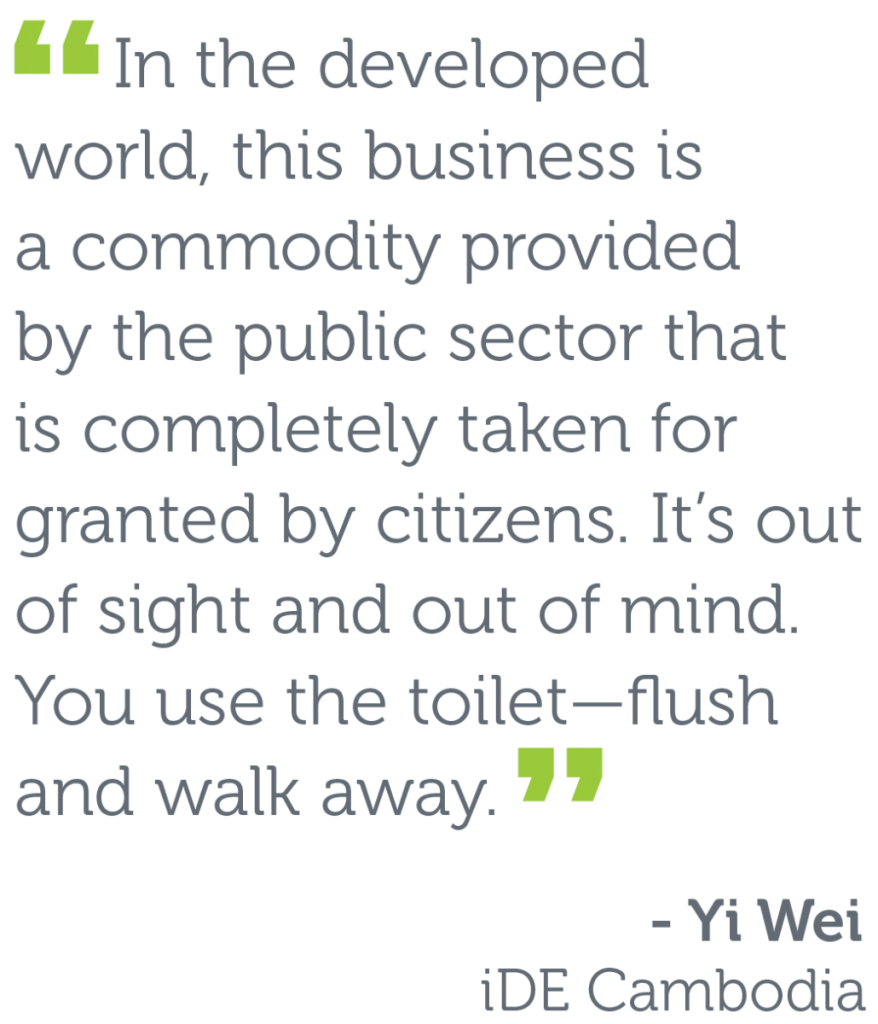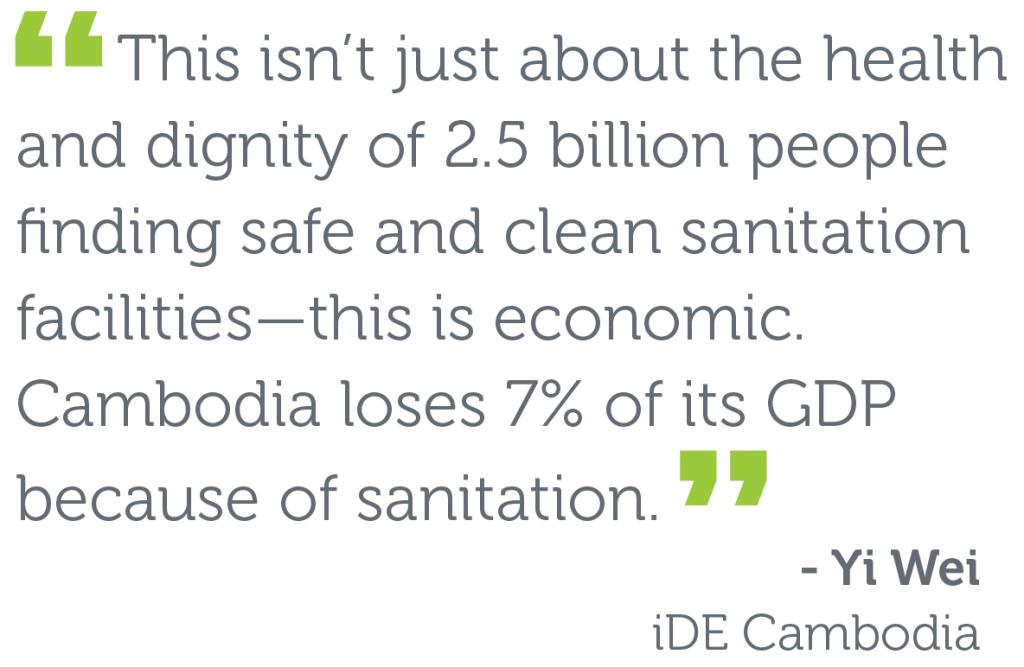This is Part I in a three-part series about innovations in global sanitation, following the Unclogging Blockages in Sanitation conference in Kampala, Uganda.

Yi Wei collaborates with others at the Unclogging Blockages Conference to explore opportunities for business in the water, sanitation, and hygiene sector. Photo courtesy of Water for People.
“So what brings you to the shit world?”
This was the first thing Emily Wood asked me as I sat down next to her at the Unclogging the Blockages in Sanitation conference, in Kampala, Uganda this February, which was made possible by support from the Bill and Melinda Gates Foundation. I was halfway through day one of the conference and I felt like I had already been initiated.
My shock at the frequent use of the word quickly dissipated as I continued to talk with other industry experts attending the conference. “We are proponents of using the word” Yi Wei, an innovation manager at International Development Enterprises (iDE), told me matter-of-factly. “This is an industry where we keep it real – we are dealing with a real issue and frankly, it gets people’s attention. This is a massive global problem and it’s not exactly a sexy topic. If we are going to really solve it, we need all the attention we can get.”
Touché. With that, I quickly pushed away the vision of my prim and proper mother’s horrified face, unwrinkled my nose, and decided to learn everything I could about an issue that typically elicits giggles or grimaces by those who flush and forget.
Toilets Are Only Funny If You Have One
I got the call on a Tuesday. “We need more MBAs in sanitation. Can you get on a plane in five days to participate in a sanitation conference in Kampala, Uganda?” The effervescent voice on the other end of the line was John Sauer from Water for People. I had never met or spoken to John before; he had heard of MBAs Without Borders through one of our partners, PATH. Even over the phone, John’s bubbly enthusiasm was infectious and I knew I had to go. I packed my bags and five days later I found myself surrounded by talk of toilets and sewage and how greater engagement with the business community could better support the industry’s needs.
Admittedly, like most Americans, I never really thought about the profit potential of the sanitation industry—no one really thinks about toilets (and their contents) as a booming business. I never contemplated the massive infrastructure in place that allowed me to flush the toilet and literally walk away without a second thought—strictly leaving discussions of bodily functions to comedians. The truth is, for a majority of the world, sanitation is no laughing matter; it’s a killer.
According to the World Health Organization (WHO), In Africa, 115 people die every hour from diseases linked to poor sanitation, hygiene, and contaminated water and 2.6 billion people worldwide live without access to basic sanitation facilities. One billion of these have no toilet at all and are forced to push their dignity to the side, defecating out in the open, near rivers, homes, and areas where food is prepared or grown, greatly increasing the risk of transmitting disease.
I continued to read through WHO’s ten startling facts on sanitation and cringed when I read that, “One gram of feces may contain 10 million viruses, one million bacteria, 1000 parasites cysts, and 100 worm eggs, and 1.1 million liters of raw sewage is dumped into the Ganges River in India—EVERY MINUTE.” Imagine what that means. For me, it was both easy and horrifying; I’ve been on a boat in that very river and remember being sadly dismayed by the amount of pollution I could see. What I didn’t realize is that I was essentially floating on the equivalent of a giant petri-dish of pathogens. The Ganges is sacred to Hindus; many who pilgrim to cities like Varanasi from around the world to bathe in the holy waters of the Ganges—many who are unaware, as I was, of the river’s condition.
Sadly, as someone who frequently travels to various destinations around the world, I wasn’t profoundly shocked by what are in fact appalling statistics. I’ve had more experiences than I care to share that involve crappy (literally) sanitation facilities or lack of facilities all together. What hadn’t occurred to me, and what I quickly learned at the conference, was what those numbers mean from a business perspective. Close to 2.5 billion people is a giant market, and the potential business opportunities to address the need for sanitation seemed obvious. So where was the business community?
Cracking the Porcelain Code
In emerging and frontier markets, the sanitation story is very different. In established markets like the United States and Europe, sanitation has been adequately addressed for over a century. From sewage systems to waste treatment plants, the foundation of an integrated and complex sanitation infrastructure was laid out decades ago. In less developed markets where infrastructure lags behind population growth, such systematization is hard to achieve.

In many emerging and frontier markets, complex sanitation infrastructure is non-existent or only available in urban hubs. In most of these markets, the cost of constructing such a complex system today would be nearly untenable. Construction material is far more expensive and labor standards make the wages necessary to complete such a feat cost prohibitive. Leaders of these countries lack the financial capacity to build infrastructure systems that can mirror those found in other parts of the world. The sanitation problem needs a radically different solution.
Historically, foreign aid organizations have tried to support governments by funneling money into public funds that support sanitation services and systems. The typical result was a lot of hand-outs and subsidies—poor short-term answers that have little, long-term impact.
Over dinner, I sat down with Yi Wei from iDE, who is seeking to understand the barriers and opportunities for business in sanitation. Three years ago, the chic Yi, a social innovator and classical percussionist, moved to Cambodia to get her hands dirty looking for a sustainable solution through her work with iDE’s Global WASH initiative.
Yi’s experience mirrored my own: “In the developed world, this business is a commodity provided by the public sector that is completely taken for granted by citizens. It’s out of sight and out of mind. You use the toilet,flush, and walk away.” Yi explained that, through its research, iDE quickly learned that when people are given a free toilet, it goes unused. “You don’t gain buy-in when something is given to you as a hand-out. Freebie toilets are not designed with the user in mind, and frankly the world can’t afford to give everyone in the world a toilet.” These three critical realizations fuel iDE’s approach to their sanitation product design, construction, and distribution process.
The Economics of Sanitation
Organizations, like iDE, that are trying to re-invent the business of sanitation, are relying on human-centered design to guide their approach. iDE understands that using a toilet is not only a very personal activity, but also cultural. How a person uses a toilet varies greatly from market to market, between genders, and among classes. Sending cookie-cutter toilets that are not designed with the user in mind will not encourage behavior change.
So what is the solution? The evolution of the industry, Yi explains, is the privatization of sanitation and water. Early on, iDE recognized that the key to success was engaging the private sector and designing more user-focused sanitation products. By taking a human-centered design approach, iDE designs toilets and sanitation products that are tailored to the particular needs, wants, and desires of consumers in the various markets they work in, increasing the likelihood that they will change behavior around sanitation.
Fixing the sanitation problem not only creates an industry that can fuel economic growth, but also plugs the leakage of wasted capital. Poor sanitation is not only linked to massive health problems but also stunted growth and poor performance at work and school. The wealth leakage related to sanitation problems doesn’t just affect individual families or villages—but an entire country’s economy.
The sanitation industry holds huge business opportunities for multinational companies and for local businesses as well. Localizing and privatizing the entire system creates a massive opportunity to create an industry with huge economic catalyzing potential. From a private sector perspective, the sanitation industry has enormous space for innovation, from products to new business models. A global economy has not only opened the door to import and export affordable sanitation products and widgets, but it also holds great potential for local businesses. With few large foreign companies in the market, local companies in emerging and frontier markets have a competitive advantage to lead the charge in an industry that is still awaiting its boom. Toilets themselves are designed around relatively simple technology, and porcelain thrones are not required—toilets can be made out of cement, plastic, and even wood. The possibilities are endless and with some ingenuity, toilets can be made from locally sourced materials and the removal, collection, and treatment of feces are largely unsaturated markets, giving local companies even more space to grow and thrive.

Yet, building and scaling an industry is no easy feat. Most financial institutions consider sanitation to be an extremely risky investment, making it difficult for local businesses to access the capital needed to grow and scale. Organizations like Water for People prioritize supporting local companies to develop sanitation product lines, providing the access to capital they need to build their business. In Malawi, Water for People partnered with a local consulting company TEECS Limited to provide sanitation businesses in Malawi with technical assistance and capacity building services. After two years of witnessing the frustrating circumstances surrounding financing options, TEECS spun off a micro-finance arm to provide micro-loans to the most promising businesses.
At the conference, we learned that in Kampala, for example, only 12% of the city is connected to a sewer, and the sewage system itself is 90 years old, and Kampala is only one of hundreds of cities in the world facing similar or more dire circumstances. One thing is certain, we can’t fall prey to how easy it is to flush and forget.
Read part II in this series on global sanitation innovation.
Feature photo courtesy of iDE Cambodia.
Jailan Adly
Jailan Adly is the Director of MBAs Without Borders where she is responsible for the overall design and implementation of the MBAs Without Borders program. In addition, she manages various International Corporate Volunteer programs for clients such as IBM, FedEx, John Deere, Medtronic, and Novartis in Morocco, Tanzania, South Africa, Tunisia, and India.








I disagree with this statement! “In established markets like the United States and Europe, sanitation has been adequately addressed for over a century.”
It’s the legal-regulatory-code environment in the United States that forces us to shit in our drinking water and send a toxic mix of industrial effluents and human excreta to energy-intensive wastewater treatment plants. Come on MBAs without Borders! Take a look at the mess in your own backyard. Your innovations and clout are needed here at home. Let’s not foist upon the developing world systems that we have not personally tested.
Pingback: WASHplus Weekly: Focus on Sanitation as a Business | Sanitation Updates
This is very inspiring to hear. I would like to hear more of it.
Pingback: MWBs Use Business to Build Sanitation Markets in Africa